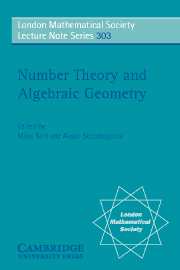Book contents
- Frontmatter
- Contents
- In Lieu of Birthday Greetings
- Peter Swinnerton-Dyer's mathematical papers to date
- On the Hasse principle for bielliptic surfaces
- Effective Diophantine approximation on Gm
- A Diophantine system
- Valeurs d'un polynôme à une variable représentées par une norme
- Constructing elements in Shafarevich–Tate groups of modular motives
- A counterexample to a conjecture of Selmer
- Linear relations amongst sums of two squares
- Kronecker double series and the dilogarithm
- On Shafarevich–Tate groups and the arithmetic of Fermat curves
- Cascades of projections from log del Pezzo surfaces
- On obstructions to the Hasse principle
- Abelian surfaces with odd bilevel structure
On the Hasse principle for bielliptic surfaces
Published online by Cambridge University Press: 04 August 2010
- Frontmatter
- Contents
- In Lieu of Birthday Greetings
- Peter Swinnerton-Dyer's mathematical papers to date
- On the Hasse principle for bielliptic surfaces
- Effective Diophantine approximation on Gm
- A Diophantine system
- Valeurs d'un polynôme à une variable représentées par une norme
- Constructing elements in Shafarevich–Tate groups of modular motives
- A counterexample to a conjecture of Selmer
- Linear relations amongst sums of two squares
- Kronecker double series and the dilogarithm
- On Shafarevich–Tate groups and the arithmetic of Fermat curves
- Cascades of projections from log del Pezzo surfaces
- On obstructions to the Hasse principle
- Abelian surfaces with odd bilevel structure
Summary
From the geometer's point of view, bielliptic surfaces can be described as quotients of abelian surfaces by freely acting finite groups, that are not abelian surfaces themselves. Together with abelian, K3 and Enriques surfaces they exhaust the class of smooth and projective minimal surfaces of Kodaira dimension 0. Because of their close relation to abelian surfaces, bielliptic surfaces are particularly amenable to computation. At the same time they display phenomena not encountered for rational, abelian or K3 surfaces, for example, torsion in the Néron–Severi group, finite geometric Brauer group, non-abelian fundamental group. This curious geometryis reflected in amusing arithmetical properties of these surfaces over number fields.
The behaviour of rational points on bielliptic surfaces was first studied by Colliot-Thélène, Swinnerton-Dyer and the second author in relation with Mazur's conjectures on the connected components of the real closure of -points. The second author then constructed a bielliptic surface over ℝ that has points everywhere locally but not globally; moreover, this counterexample to the Hasse principle cannot be explained by the Manin obstruction (see also, Ch. 8). D. Harari showed that bielliptic surfaces give examples of varieties with a Zariski dense set of rational points that do not satisfy weak approximation; moreover this failure cannot be explained by the Brauer–Manin obstruction.
- Type
- Chapter
- Information
- Number Theory and Algebraic Geometry , pp. 31 - 40Publisher: Cambridge University PressPrint publication year: 2004
- 2
- Cited by

